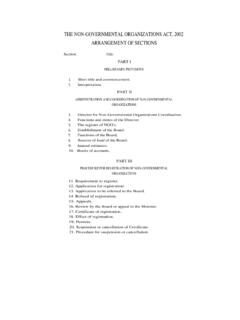Transcription of Publication 4484 (rev. 04-2021) - IRS tax forms
1 Choose Including plans for employees of tax-exempt and government entities (schools, hospitals, churches, charities) Highlights of eight types of retirement plans What is the maximum annual contribution? Which plans offer catch-up contributions? What are the minimum employee coverage requirements? When should distributions begin?Plan Feature Comparison Charta Retirement Plan2 Advantages of Having a Retirement Plan,By starting a retirement savings plan, you ll help your employees save for the future, and you ll help secure your own retirement. Offering a retirement plan may also help you attract and retain better qualified advantages have made it more appealing than ever to establish and contribute to a retirement Advantages: Contribution limits that allow employees and employers to contribute large amounts to retirement plans.
2 Catch-up rules that allow employees age 50 and over to set aside additional amounts. In some plans, employees can invest a certain amount of their salary before it is taxed. A tax credit, known as the Retirement Savings Contributions Credit, is available for eligible contributions to a retirement plan. This credit could reduce federal income tax up to 50 cents on the dollar. Money in the retirement program grows a Retirement Plan,The most basic retirement plan is an Individual Retirement Arrangement (IRA). Private-sector employers (for-profit and not-for-profit) and government employers can offer savings plans that use IRAs to hold savings plans include Payroll Deduction IRAs, Simplified Employee Pension (SEP) plans and Savings Incentive Match Plan for Employees of Small Employers (SIMPLE) IRA plans.
3 In these plans, and also with 401(k), 403(b) and 457(b) plans, the ultimate retirement benefits depend on the dollar amount accumulated in the employee s estimate that in the American workforce as a whole, workers will need 70 to 90% of their pre-retirement income to maintain their current standard of living when they stop working. Lower income earners may need more than 90%. Among these workers 25-64 years of age, a little more than half are participants in an employer-sponsored retirement A RETIREMENT PLAN23A defined benefit plan promises a specific benefit at retirement $1,000 a month, for example. The amount of this benefit is often based on a set percentage of pay multiplied by the number of years the employee worked for the employer offering the Plan Correction ProgramsThe IRS has programs structured to provide financial incentives for finding and correcting mistakes earlier rather than later.
4 In fact, many mistakes can be corrected easily, without penalty and without notifying the IRS system of retirement plan correction programs, the Employee Plans Compliance Resolution System (EPCRS), helps business owners protect participant benefits and keep their plans within the law. EPCRS includes:Self-Correction Program Find and correct a mistake before an Correction Program Correct your plan s mistakes with help from the Closing Agreement Program If the IRS examines your plan and finds an error, you can still correct the problem. However, the fee will be larger than if you found and fixed the error yourself, or brought it in A RETIREMENT PLAN34 Plan Feature Comparison ChartStarting with the brief summary table below, find the plans that fit you and your employees best.
5 Then click on the plan tabs to view and compare the details on each RETIREMENT PLANSS ponsor/ Eligible EmployerKey AdvantagePlans to ConsiderLearn More Any employer easy to set up and maintainPayroll Deduction IRA Any employer easy to set up and maintainSEP Employers with 100 or fewer employees that do not currently maintain another plan salary reduction plan with little administrative paperworkSIMPLE IRA Any non-government employer Governments, only if plan was established prior to May 1986 permits high level of salary deferrals by employees may include designated Roth program401(k) Public education employers 501(c)(3) organizations permits high level of salary deferrals by employees may include designated Roth program403(b) State and local governments permits high level of salary deferrals by employees may include designated Roth program457(b) governmental Any tax-exempt organization permits high level of salary deferrals by employees457(b) Tax-Exempt Organization (Non-Church)
6 Any employer provides a fixed, pre-established benefit for employeesDefined Benefit45 Payroll Deduction IRAS ponsor/Eligible Employer, any employerKey Advantage easy to set up and maintainEmployer s Role arrange for employees to make payroll deduction contributions transmit contributions for employees to IRA no annual filing requirementContributors to the Plan employee can decide how much to contributeMaximum Annual Contribution (per participant) employee: $6,000 for 2021 Catch-Up Contributions age 50 or over additional employee contribution $1,000 Minimum Employee Coverage Requirement should be made available to all employeesWithdrawals, Loans and Distributions withdrawals permitted any time subject to federal income taxes subject to 10% additional tax if before age 59 must start receiving distributions by April 1 of the year following attainment of age 72 (70 if you turned 70 before January 1, 2020) (special rules apply to Roth IRAs)
7 Loans are not permitted from IRAsRollovers/Transfers rollovers permitted from one IRA to another and to an eligible retirement plan (special rules apply to Roth IRAs)Vesting contributions are immediately 100% vestedEPCRS, no6 SEPS ponsor/Eligible Employer, any employerKey Advantage easy to set up and maintainEmployer s Role set up plan employer may use form 5305-SEP transmit contributions for employees to SEP-IRA generally, no annual filing requirement bank or financial institution handles most of the paperworkContributors to the Plan employer can decide whether to make contributions year-to-year only employer contributesMaximum Annual Contribution (per participant)
8 Up to 25% of compensation but no more than $58,000 for 2021,Catch-Up Contributions N/AMinimum Employee Coverage Requirement must be offered to all employees who are at least 21 years of age, employed by the employer for 3 of the last 5 years, and had compensation of at least $650 in 2021 Withdrawals, Loans and Distributions withdrawals permitted any time subject to federal income taxes subject to 10% additional tax if before age 59 must start receiving distributions by April 1 of the year following attainment of age 72 (70 if you turned 70 before January 1, 2020) loans are not permitted from SEP-IRAsRollovers/Transfers rollovers permitted from one IRA to another and to an eligible retirement planVesting contributions are immediately 100% vestedEPCRS, yes7 SIMPLE IRAS ponsor/Eligible Employer.
9 Employer with 100 or fewer employees that does not currently maintain another planKey Advantage salary reduction plan with little administrative paperworkEmployer s Role set up plan employer may use form 5304-SIMPLE or form 5305-SIMPLE transmit contributions for employees to SIMPLE IRA no annual filing requirement bank or financial institution handles most of the paperworkContributors to the Plan employee can decide how much to contribute employer must make matching contributions or contribute 2% of each eligible employee s compensationMaximum Annual Contribution (per participant) employee: $13,500 in 2021 employer: either match employee contributions 100% of first 3% of compensation (can be reduced to as low as 1% in any 2 of 5 years)
10 , or contribute 2% of each eligible employee s compensationCatch-Up Contributions age 50 or over additional employee contribution $3,000 in 2021 Minimum Employee Coverage Requirement must be offered to all employees who have compensation of at least $5,000 in any prior 2 years and are reasonably expected to earn at least $5,000 in the current yearWithdrawals, Loans and Distributions withdrawals permitted any time subject to federal income taxes subject to 10% additional tax if before age 59 (25% if less than 2 years of participation) must start receiving distributions by April 1 of the year following attainment of age 72 (70 if you turned 70 before January 1, 2020) loans are not permitted from SIMPLE IRA plansRollovers/Transfers rollovers permitted from one SIMPLE IRA to another SIMPLE IRA any time however, a rollover from a SIMPLE IRA to a non-SIMPLE IRA or to an eligible retirement plan can be made tax-free only after a 2-year participation in the SIMPLE IRA planVesting employer and employee contributions are immediately 100% vestedEPCRS, yes8401(k)













